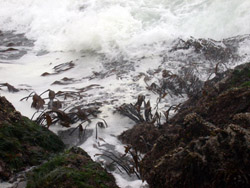Bryce Wolcott

I am interested in size and scaling in biology, because body size often has non-intuitive consequences in the mechanics of organisms and in metabolic processes. Experimental physiologists have long known that factors external to an organism (e.g. environmental temperature, food intake, water flow, ambient light) can influence metabolic rate. They often are joined by theorists interested in metaboloic scaling, however, in assuming that these factors exert a proportionate influence on metabolic rate that is independent of body size. The limited data available suggest that this assumption may rarely be valid. For my thesis work, I am examining the influence of water temperature, ambient fluid flow, and the mechanical forces generated by ocean waves on the scaling of metabolic rate with body size in a local sea urchin (Strongylocentrotus purpuratus). By comparing my data to predictions based on previous treatments in the literature which ignore size and scaling, my project will highlight the need for experimental physiologists and theoretical modellers to consider scaling, and factors which may influence it, in their studies. I will also compare my results to predictions I can make based on the mechanics of fluid flow, to determine whether induced changes in metabolic rate occur in a predictable manner that can be incorporated into future models of scaling.
I am also fond of stomping around in the rocky intertidal zone, and have become interested in recent papers attempting to predict rates of disturbance by ocean waves in this habitat. The forces imposed by these waves on intertidal organisms can be quite large, and an animal or alga is ripped from the substratum whenever the hydrodynamic force imposed by a wave is greater than the organism's ability to resist that force. Larger waves produce larger forces, and sites exposed to more intense wave action are generally associated with higher levels of disturbance. I have found, however, that substratum quality also differs between sites, so that organisms at protected sites may be at greater risk of mortality than those at more exposed sites nearby. I am currently following two populations of Pelvetiopsis limitata, at a wave-exposed and protected site, to examine differences in morphology, attachment strength, and mortality between the sites. By tracking these properties throughout the year, I can test predictions of disturbance at each site, and observe the effects of wave-exposure and substratum quality on algal size, morphology, and life-history.
Publications
- Koehl, M. A. R. and B. D. Wolcott (2004) Can function at the organismal level explain ecological patterns? Ecology 85: 1808-1810.
- Wolcott, B. D. (2007) Mechanical size limitation and life-history strategy of an intertidal seaweed. Mar. Ecol. Prog. Ser. 338: 1-10 Link to Article
